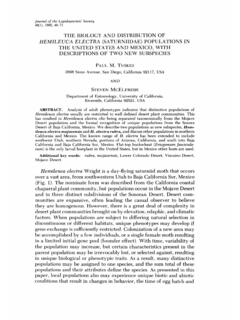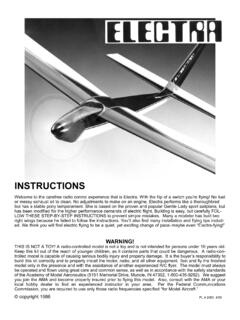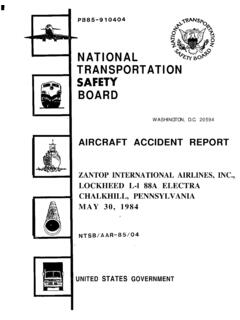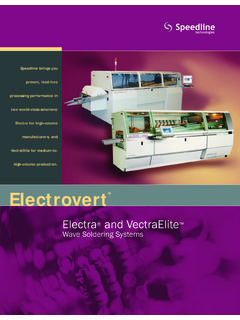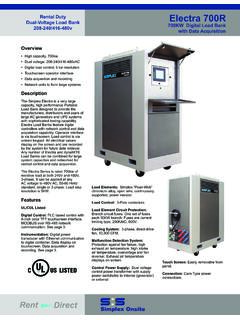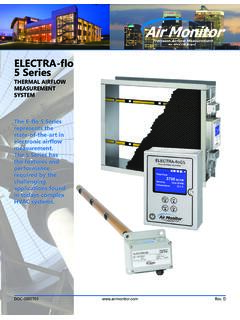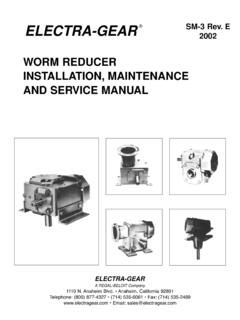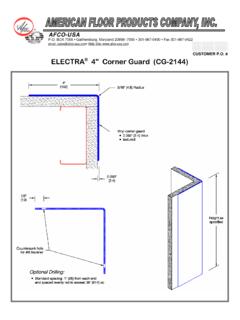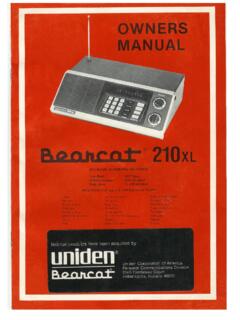Transcription of PHOTOIMAGEABLE SOLDERMASK - Allen Woods Group
1 EMP110 Page 1 of 10 PRODUCT DESCRIPTION Carapace EMP110 has been used in the high volume production of PCBs since 1987. Carapace EMP110 HD is the latest development of the range, formulated to exceed the increasing demands of PCB processes, combined with a large process window. Fine solder dam resolution (50 m, (2 mil). 50 micron solder-dams (exposed using Olec ATH30) Fast processing times allowing high throughput and productivity. Optimised rheological and coating properties for each method of application. Low ionic contamination. Solderball elimination. High moisture and insulation resistance High resistance to low solids fluxes. Excellent adhesion to flexible substrates. Low odour. TGIC-Free version suitable for all final finish requirements Halogen-free Reach and RoHS compliant Carapace EMP110 is a contact exposure, aqueous developing, liquid PHOTOIMAGEABLE SOLDERMASK , using two-component epoxy technology to give high levels of chemical resistance over copper, copper oxide or gold plated circuits.)
2 Due to their resolution capability, high dielectric strength and physical resistance properties Carapace EMP110 soldermasks are used as solder resists and insulation coverings on all types of printed circuits, particularly high-reliability, double-sided and multilayer, fine line, surface mount boards. TECHNICAL DATASHEET CARAPACE EMP110 HD High Definition PHOTOIMAGEABLE SOLDERMASK EMP110 Page 2 of 10 CARAPACE EMP110 PRODUCT RANGE PASTES: All Carapace pastes are coded as EMP110 followed by numbers and letters. The number and letters denote the colour, finish and application method. Carapace EMP110 HD is available as standard in the following: Screen-print: EMP110/5158 HD TG (Transparent Gloss) EMP110/5410 HD TM (Transparent Matt) Air-spray: EMP110/5393EM TG HD AS (Transparent Gloss) EMP110/5396EM TM HD AS (Transparent Matt) HARDENERS: 1) EMP110 PtB - The following hardener is grouped into the EMP110 PtB class: EMP110 Pt B (H-4090) Transparent EMP110 Pt B (H-4090 G) Green EMP110 Pt B (H-4090 DG) Dark Green EMP110 Pt B (H-4090 LG) Light Green EMP110 Pt B (H-4090 N) Black EMP110 Pt B (H-4090 B) Blue EMP110 Pt B (H-4090 R) Red EMP110 Page 3 of 10 Board surface preparation: Mechanical pre-cleaning: Brush 320 to 400 grit silicon carbide brushes with a recommended footprint on the copper of 10-15mm.
3 ( inches). Brushes should be regularly checked and dressed to ensure optimum preclean is retained. Pumice Slurry Scrub Pumice concentration between 18 - 22% (v/v) is recommended (3F or 4F virgin grade). Slurry should be changed between 500-1000 panels Aluminium Oxide Slurry Scrub Aluminium oxide concentration between 18 - 22% (v/v) is recommended (400 grit). Slurry should be changed between at least 20,000-30,000 panels Aluminium Oxide Jet Slurry Spray is known to give lower surface roughness compared to other pre-clean methods. Where no other alternative method is available then the following conditions are suggested: Aluminium oxide concentration between 18 - 22% (v/v) is recommended (220 grit virgin grade). Jet spray pressure 20-24 PSI ensuring the jet nozzle patterns fully overlap Slurry should be changed between at least 10,000-20,000 panels Panels must be fully rinsed such that any slurry particles are completely removed.
4 Failure to remove particles can result in poor cosmetics and adhesion loss. If panels are heavily oxidised and tarnished then a micro-etch prior to mechanical pre-cleaning is strongly recommended. Panels must be thoroughly rinsed prior to mechanical cleaning stage. Recommended Surface roughness figures are Ra m. Chemical pre-cleaning: High Roughness, Deep-Etching Clean Due to the excellent mechanical bond achieved between the copper surface and SOLDERMASK , proprietary deep-etch chemistries are the preferred method of pre-clean. For a list of recommended and approved chemistries, please contact your electra representative. Microetch Clean Simple microtech solutions such as sodium persulphate are not recommended as the sole method of preclean. In all cases panels must be thoroughly rinsed and dried such that no tarnish is present and no water moisture remains in the holes or between closely spaced tracks.
5 It is recommended that all freshly cleaned panels are coated within 2-4 hours. The actual maximum time will vary depending upon ambient temperature and humidity. Panels left longer than 4 hours should be re-cleaned prior to coating. EMP110 Page 4 of 10 Mixing: Carapace EMP110 HD is supplied in pre-weighed packages of paste + hardener. The original supplied mix ratio must be used if mixing smaller amounts than the standard pack-size. Stir well to ensure complete mixing. Incomplete mixing can cause poor developing, stickiness during exposure and impaired final properties. Viscosity reduction: SP formulations: SP versions of EMP110 are supplied screen ready. If viscosity adjustment is required prior to, or during printing, then this may be achieved using Electrareducer ER1.
6 No more than 5% reducer should be added or deterioration of the printing and drying properties may occur, resulting in thin deposits on track edges and/or prolonged drying times. AS formulations: It is advisable to use a slow speed mechanical mixer when mixing in solvent. Care should be taken to avoid incorporating air into the resist during mixing. Resist should be allowed to stand for 2 hours after mixing to allow air to escape. Excessive air in resist can cause microbubbles/voids in the finished film and/or poor curtain stability when curtain-coating EMP110 HD AS soldermasks using EMP110 Pt B H-4090 should be reduced with Electrareducer ER6. Where ER6 is not available, an equivalent from an approved source may be used.
7 The use of non-approved solvents is not recommended as they can cause contamination and other processing problems. Addition level required will depend on spray system used. Please contact electra Technical Support Department for recommendation addition levels Due to the fast viscosity readings using a Zahn3 cup, air inclusion can give erratic readings. It is therefore recommended to use the Ford N 4 or a cup giving similar values ( Frikmar N 4). Process settings: Flat-bed screen printing: Mesh count: 36 - 54T/cm (92 137 mesh) polyester. Squeegee: 60-70 Shore. 20 m dry thickness should be aimed for; this is typically achieved using a 43T/cm (110 mesh) The board outline image may be made on the screen using conventional stencil material or masking tape and screen filler.
8 To prevent a build up of ink on the reverse of the screen that may block holes, it is advisable to shift alternate boards along the x- or y-axis before printing. Alternatively, a rudimentary stencil, such as an expanded drill mask, can be used on the screen to prevent ink going into the holes. Do not utilise the vacuum bed, as this will suck an exaggerated amount of ink into the holes. EMP110 Page 5 of 10 Double-side screen printing (Circuit Automation DP machines) : Mesh count: 32-38T/cm (83 98 mesh) polyester. Squeegee: 60-70 Shore. Typically a flood-print-print cycle is recommended. Wherever possible the ISO-print feature is recommended to reduce ink deposit into larger holes. Vacuum chamber de-gassing prior to tack-drying is proven to reduce bubbling between tracks and reduce via-hole popping due to solvent entrapment.
9 Air Spray: Exact spray parameters will depend on track height and circuit layout. These parameters will also depend on equipment manufacturer, please contact electra Technical Support Department for specific recommendations. Below are general recommendations and guidelines: Wet-thickness: 60 to 100 m ( to 4 mils) Tank pressure and coating speed are set to give desired wet thickness. Atomising pressure should be set to give minimal mottling. Shaping air is to be adjusted to give an even spray pattern. Lower atomising pressures and higher coating speeds will lead to increased mottling. Tack-dry: The aim of the tack-drying stage is to solely remove the solvents. It is important for the drying chamber (static or conveyorised) to have good air circulation with air supply and extraction facilities.
10 Convection dry Recommended drying settings and hold times will vary with hardener selection, see below. Hardener Recommended/Max temperature Recommended/Max time (mins) Max hold-time after optimum tack-dry H-4090 75/80 C (167/176 F) 40/60 72 hours IR Drying IR drying is dependent on coating application method, IR wave-length and IR intensity. Please contact electra Technical Support Department for recommendations regarding specific equipment types and manufacturers. EMP110 Page 6 of 10 Exposure Spectral output: 310-420 nm. Optimum wavelength is approx. 365-385nm. Step wedge: 10-12 clear (Stouffer 21 step). Note: exact milliJoule requirements will vary with formulation type. Determination of the correct exposure should be carried out after setting the developing speed since this will affect the step wedge reading obtained.

